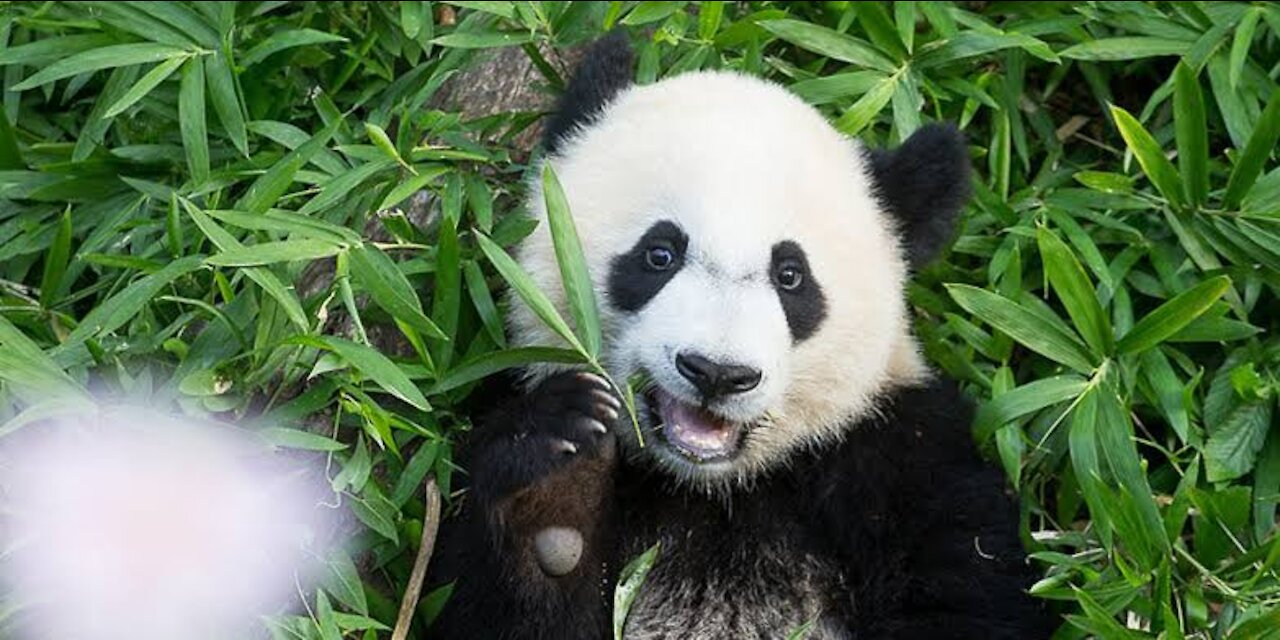Premium Only Content

Cute Panda Footage
1. THEY HAVE GREAT CAMOUFLAGE FOR THEIR ENVIRONMENT
The giant panda's distinct black-and-white markings have two functions: camouflage and communication. Most of the panda - its face, neck, belly, rump - is white to help it hide in snowy habitats. The arms and legs are black, helping it to hide in shade.
2. THEIR EYES ARE DIFFERENT TO NORMAL BEARS
Like domestic cats, giant pandas have vertical slits for pupils.
Giant panda © WWF China / Yong Yange© WWF China / Yong Yange
3. CUBS ARE WELL PROTECTED IN THEIR FIRST MONTH
Mother pandas keep contact with their cub nearly 100% of the time during their first month - with the cub resting on her front and remaining covered by her paw, arm or head.
Juvenile giant panda climbing© naturepl.com / Pete Oxford / WWF
4. COURAGEOUS CUBS!
At 5 months old, giant pandas learn how to climb - sometimes practicing by climbing on their mum.
Portrait of a giant panda ( Ailuropoda melanoleuca ). Bifengxia Panda Base, Sichuan. China © Richard Barrett / WWF-UK© Richard Barrett / WWF-UK
5. A HELPING HAND
They have an extended wrist bone that they use like a thumb to help them grip food.
Giant panda eating Bamboo© Sharon Fisher
6. THEY SPEND A LOT OF THEIR DAY EATING
Giant pandas spend 10-16 hours a day feeding, mainly on bamboo.
Giant panda eating bamboo© Richard Barrett / WWF-UK
7. BAMBOO IS CRITICAL TO THEIR DIET
Pandas need at least 2 different bamboo species in their range to avoid starvation
Giant Panda Zhen Zhen visiting the Panda Research Camp Wuyipang, China© George B. Schaller / WWF
8. BUT THEY DO OCCASIONALLY EAT SOMETHING OTHER THAN BAMBOO
Although pandas are 99% vegetarian their digestive system is typical of a carnivore. For the 1% of their diet that isn't bamboo, pandas eat eggs, small animals, carrion, and forage in farmland for pumpkin, kidney beans, wheat and domestic pig food.
Wild Giant Panda scenting a tree© Anzihe Nature Reserve/WWF China
9. PANDAS SOMETIMES DO HANDSTANDS WHEN THEY WEE!
Sometimes, to mark their scent, panda's climb a tree backwards with their hindfeet until they're in a full handstand upside down - enabling them to leave their scent higher up.
Giant panda in tree, Wolong Nature Reserve, China.© Bernard De Wetter / WWF
10. THEY LIKE TO KEEP IT REGULAR
On average, pandas poo 40 times a day.
-
 LIVE
LIVE
Nerdrotic
2 hours agoStar Wars GRAPED? Hollywood In Freefall, Silver Surfer is a MAN! | Friday Night Tights 351
4,040 watching -
 LIVE
LIVE
Dr Disrespect
6 hours ago🔴LIVE - DR DISRESPECT - PUBG - 5 CHICKEN DINNERS CHALLENGE
8,567 watching -
 1:36:46
1:36:46
RiftTV/Slightly Offensive
2 hours ago $4.48 earnedTrump SHUTS DOWN War with Iran! Bibi IN RAGE | Guest: Joel Webbon | The Rift Report
11.9K5 -
 LIVE
LIVE
Jamie Kennedy
18 hours agoThe Illusion of Time, Portals, and Paranormal Activity | Ep 203 with Jay Wasley of Ghost Adventures
129 watching -
 14:34
14:34
Bearing
9 hours agoUK Transgender Protesters are NUTS 🦄⚧🏳️⚧️
10.5K27 -
 1:41:53
1:41:53
The Quartering
4 hours agoWoke Judges ARRESTED, Rachel Zegler FAILS, McDonalds & Cancer & More
136K69 -
 2:56:07
2:56:07
The Dana Show with Dana Loesch
5 hours agoSEC DEF HEGSETH'S NEW SIGNAL CHAT CONTROVERSY | The Dana Show LIVE on Rumble!
32.9K1 -
 LIVE
LIVE
LFA TV
20 hours agoALL DAY LIVE STREAM - 4/25/25
3,217 watching -
 1:14:15
1:14:15
The Illusion of Consensus
2 days agoMaxime Bernier on Canada's Mass Immigration Crisis
17K -
 1:27:50
1:27:50
Crypto Power Hour
5 hours ago $0.38 earned“Crypto Beyond Currency” w/ Special Guests Evan Mann & Alex Popovic
15.1K4